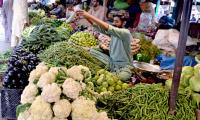As China and Pakistan mark 10 years of CPEC and enter into the second phase of the project, both countries mutually, celebrate the arrival of Chinese Vice Premier He Lifeng. The second phase is aimed at stimulating economic growth, alleviating poverty, and strengthening regional connectivity. China’s unparalleled support has escalated and uplifted Pakistan’s economic prospects, accomplishing an unbreakable bond between the nations. With substantial investments, loans, and grants, and signing six new agreements recently China emerges as Pakistan’s paramount benefactor, endorsing the most significant partnership of the decade.
Successfully entering into the second phase stands as a testament to the steadfast commitment of both nations towards seeking shared prosperity. Different MoUs were signed on multifaceted projects such as about the protocol of phytosanitary requirements for export of dried chillies from Pakistan to China, on the acknowledgement of receipt of realignment of the Karakorum Highway (KKH) Phase-II Project (Thakot-Raikot), on strengthening workers’ exchange programme was also signed between the All-China Federation of Trade Unions (ACFTU) and the Board of Investment, Pakistan under the ambit of CPEC Industrial Cooperation, an agreement on the announcement of the minutes of the 21st Conference of Technical Committees on Promoting the ML-1 project was also signed and a lot more.
In the second phase of CPEC, China has committed a generous $1 billion grant for Pakistan’s social sector development, reinforcing their partnership in pursuit of shared prosperity. The forthcoming second phase of the China Pakistan Economic Corridor (CPEC) will witness 63 additional projects, valued at approximately $35 billion, completed by 2030.
China’s expected investment of $58 billion to revitalize Pakistan’s infrastructure, energy, and production sectors arrived at a much needed time when international investors hesitated to invest in Pakistan. Creation of 2.3 million jobs from 2015 to 2030 and a commendable boost of 2 to 2.5 percent to annual economic growth, can act as a catalyst for the current economic scenario. Such milestones if achieved can contribute significantly in the prosperity of Pakistan. Now it is up to us how we can take out maximum gains out of it. This flagship project of China is a blessing for us particularly at this very juncture where no other country was ready to invest. We have to utilize the potential of CEPEC as it can be a game changer. Where investments are made in energy, IT, infrastructure and economic zones are being created, other significant sectors could have been included in this such as textiles which is the prime source of bringing in foreign reserves.
We were unable to tap the tap the potential of our textile exports, the recent plunge is an example of this. We can only hope if we could utilize the potential of CEPEC to its maximum. Policy making and sane budgeting can play a very vital role. We have borrowed $3 billion from the IMF under strict implications and simultaneously lost equivalent exports. This can have long-term implications for Pakistan’s fiscal sustainability. The question arises that what is the way forward? It’s been since long that we have been finding solutions to our never ending economic dilemmas but is there any end to this fiasco? Why are we adamant to increase our debt rather than our exports in spite having the true potential? We have tried our level best for getting into a loan agreement with the IMF yet not tried our level best to increase our exports. We could have earned this $3 billion
The commerce ministry has estimated Pakistan’s overall exports ranging between 27.5 billion and 28 billion dollars against the target of $32 billion of the current fiscal year. This time around the government seems to miss the export target. The textile sector contributes around 60% which stood at $16.63 billion for FY23, down from $18.44 billion for FY22. It is estimated to remain between $16 billion and $17 billion due to the current situation where the cost of doing business has skyrocketed along with other factors. The political instability and unstable economic policies have made us loose the both, interest and trust of our investors. The raw material and energy cost is immensely high. We could have saved our textile exports from plunging down but we did not; in fact, we further went on to remove all the incentives given to the major earning sector of the country bringing in the maximum foreign reserves.
Not implementing the previous textile policy is a story of the past, devising a new one was not taken into account. Nothing was much on the table for the five export-oriented sectors after announcing the current budget or the recent loan agreement. Electricity is the basic raw material for any production rest exports aside. The rates are free flying with every coming day for domestic and commercial users. The power hikes have totally deprived Pakistan of an enabling environment. Inflation on the other hand has massively escalated. Pakistan since its inception has never seen such volatile economic conditions where inflation rose to 37.97 percent in May of 2023. Who will consider this a reasonable deal to do the business for a 5% profit gains while paying an interest rate of 22%. This is not suitable in a healthy business environment. This inflation has severely impacted the cost of doing business and the cost of raw materials. The wages had to be increased to cope up with the increasing inflation which impacted the business environment negatively.
Numerous actors have played part such as fluctuating world demand for its exports, domestic political uncertainty, and the impact of occasional floods, its agricultural production and massive reduction in the country’s imports as against the exports. Pakistan’s exports are backed by a few sectors, such as textiles. The lack of export diversification has made the country vulnerable to external shocks, which can widen the current account deficit.
Furthermore, Pakistan has struggled to compete with other countries in terms of quality and price, further hampering its export competitiveness. Recent devaluation of the Pakistani rupee has already led to higher prices for essential goods, putting a strain on household budgets. A widening current account deficit can also discourage foreign investment in the country. Investment in a country with such dire economic conditions is deemed risky due to its external debt burden and currency devaluation. In spite of Gawadar being our resource its actual potential was realized by Xi Jinping. We need visionary leaders like that of China, who not only envisioned their own prosperity but the prosperity of other nations too. Opportunities do not come every day, after the IMF funding and beginning of CEPEC’s second phase we need to realize the potential of our other blessings and this is the need of the hour to initiate developmental reforms in other sectors such as agriculture and textile and enable Pakistan to become self-sufficient rather than relying on foreign aids.
Screengrab of viral video shows tribal members carrying out “honour killing” at unknown location in Balochistan....
JUIF Chief Maulana Fazlur Rehman addressing during "Majlis e Qaideen Meeting “organized by Milli Yakjehti Council...
resident Asif Ali Zardari presenting a souvenir to the outgoing Ambassador of Austria to Pakistan Andrea Wicke at...
Security forces killed eight terrorists belonging to Indian proxy Fitna al-Hindustan in Kalat district of Balochistan
As many as 78 Members of National Assembly attended all sittings, whereas 3pc did not attend any
Court of Judicial Magistrate Mubashir adjourned hearing while maintaining arrest warrant for Ali Amin Gandapur







